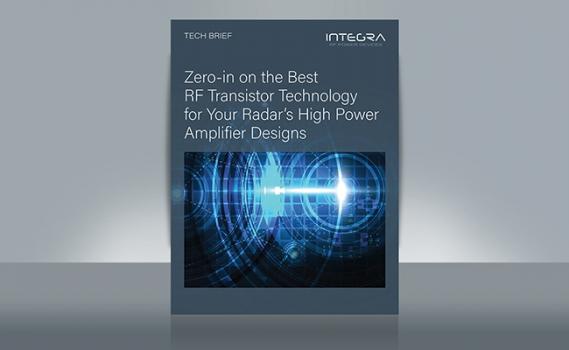Choose the Right RF High Power Transistors

Description
The best solid-state, high power amplifiers (HPAs), especially those used in critical defense, aerospace, and weather-radar applications, start with the right choice of discrete or integrated RF power transistors. This tech brief, “Zero-in on the Best RF Transistor Technology for Your Radar’s High Power Amplifier Designs”, helps you make the right choice.
Several active device semiconductor technologies are available today to amplify pulsed and continuous-wave (CW) signals across narrow or wide bandwidths from HF/VHF/UHF to L-, S-, C-, and X-band frequencies and beyond. Transistors for use in RF/microwave HPAs include some well-established, legacy device technologies such as silicon bipolar and silicon VDMOS power transistors, as well as more recent power-transistor technologies such as silicon LDMOS and gallium-nitride on silicon-carbide (GaN-on-SiC or GaN/SiC) high-electron-mobility transistor (HEMT) power transistors.
Depending upon frequency, bandwidth, and other requirements, each transistor technology offers its own set of performance benefits in terms of output power, gain, and efficiency. But evaluating the tradeoffs related to cost and value can be a daunting task. This Tech Brief by Integra is intended to give you a head start. In it they explain the key things to look for, and the advantages and disadvantages of each technology, while providing a few examples of ideal fits for certain types of applications at different frequencies, and under different waveform conditions.
RF power transistors are usually characterized for the type of signals that they will handle, such as CW or pulsed signals. And when amplifying pulsed signals, the range of signal conditions are the most complex, such as defined by your pulse width and pulse duty cycle. Although different types of RF/microwave power transistors are capable of high power efficiency, no power transistor is 100% power efficient, as some DC and RF power supplied to a power transistor will inevitably be lost as heat (which also must be dissipated). Amplifying CW signals, or long-pulse length and/or high-duty-cycle pulses, will result in more heat from one transistor technology than another and will vary when compared to handling short pulses or low-duty-cycle pulses. As a result, there is no “silver bullet” technology for all of today’s high-power amplification requirements. The only solution is to match up the key characteristics of a transistor type to your most important application requirements. But as you’ll learn, this becomes not only a spec-to spec comparison exercise, it also requires recognition of other system-level tradeoffs to arrive at the best combination of performance, reliability, thermal management, and total bill-of-materials (BOM) cost for your HPA.
